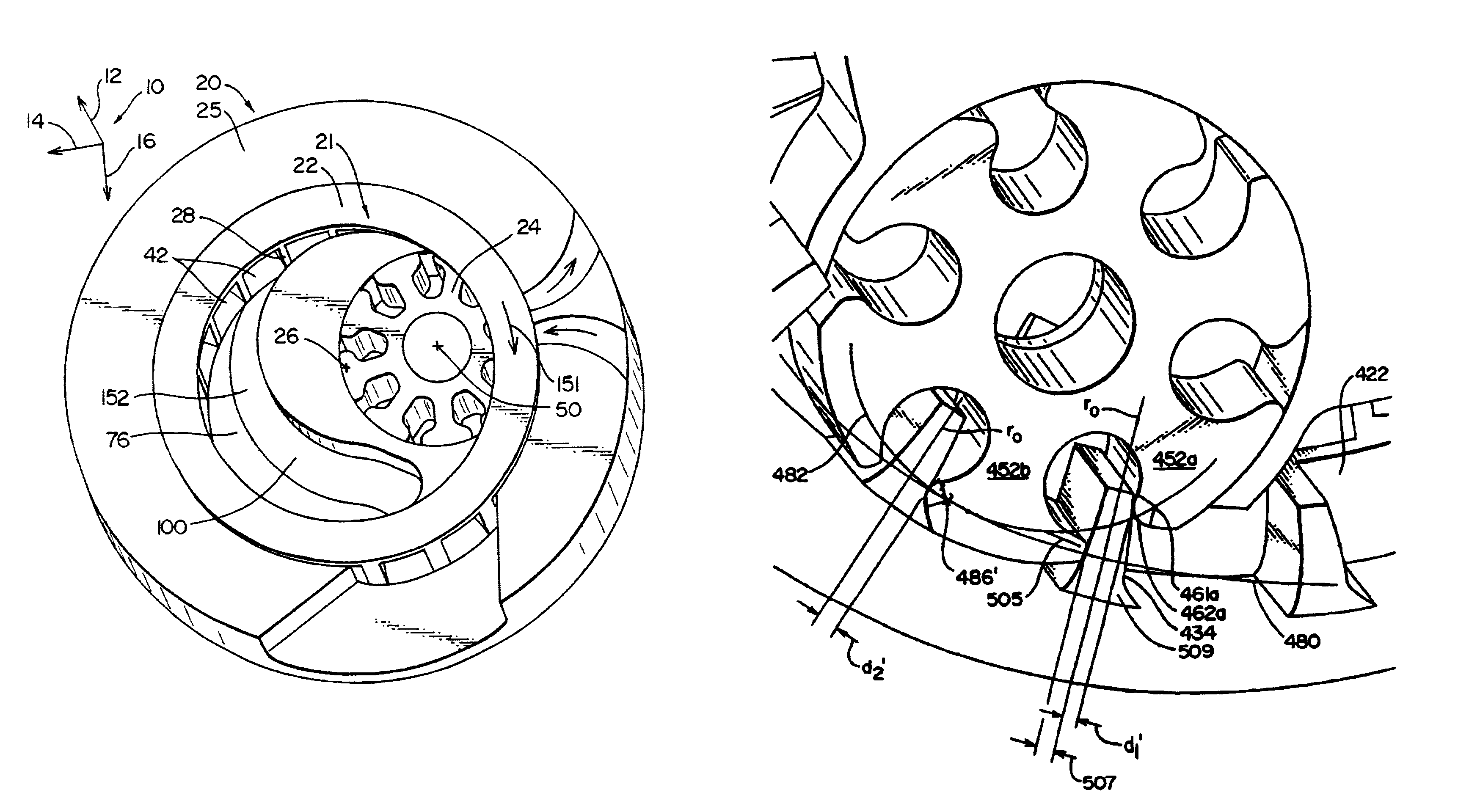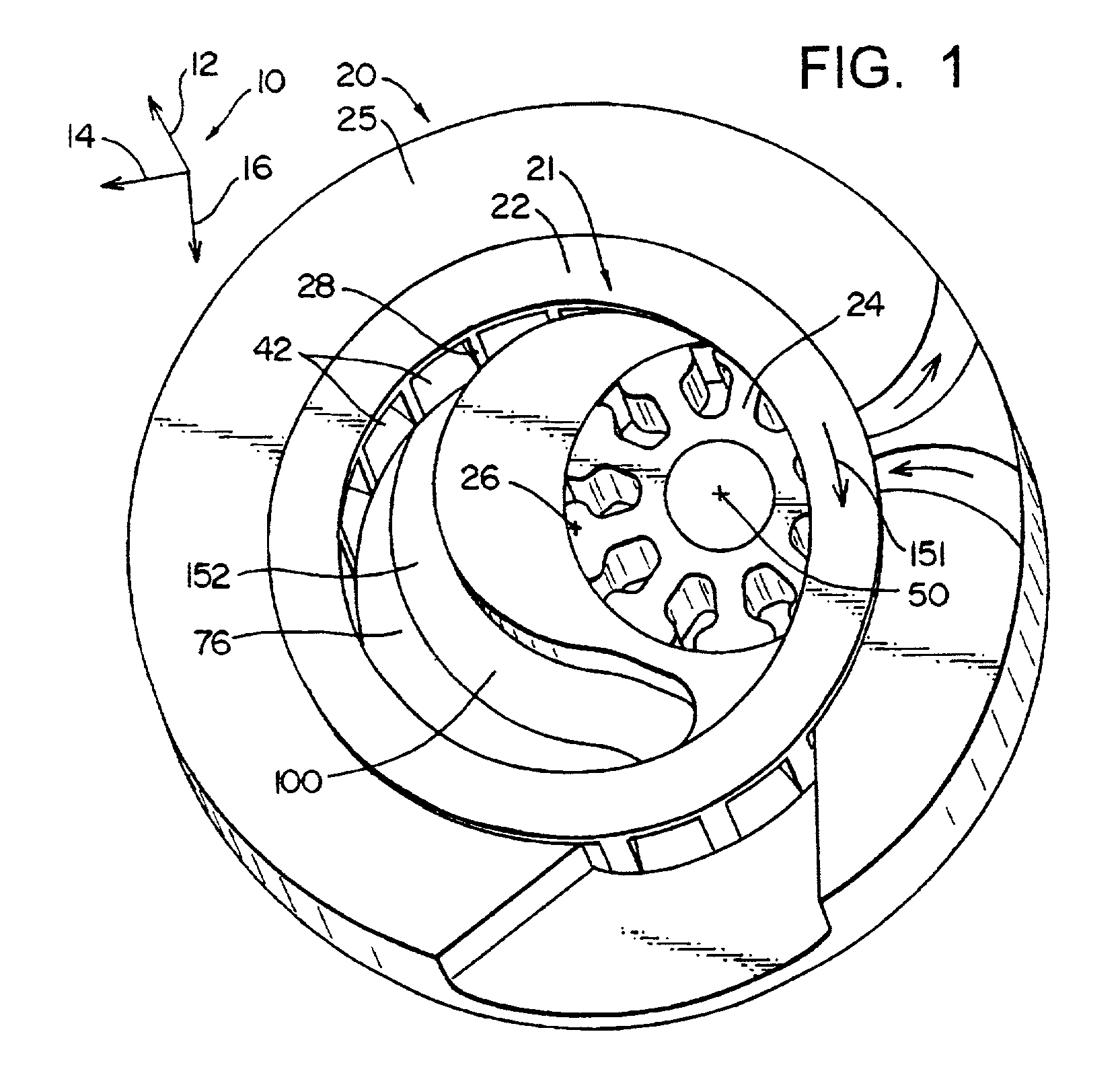Rotary positive displacement device
a positive displacement and rotary technology, applied in the direction of machines/engines, combination engines, liquid fuel engines, etc., can solve the problems of not being able to have a sealing displacement chamber in the spurs of the interior rotors are not adapted to engage either end of the recesses of the outer rotor simultaneously, and the reciprocating motion of the piston engine and the positive displacement compressor have mechanical limitations on their maximum rotation per minu
- Summary
- Abstract
- Description
- Claims
- Application Information
AI Technical Summary
Benefits of technology
Problems solved by technology
Method used
Image
Examples
first embodiment
[0048]As seen in FIG. 1, there is shown the apparatus 20 comprising a rotor assembly 21 and a housing 25. Shown in FIG. 1, the rotor assembly 21 comprises an outer rotor 22, and an inner rotor 24. The outer rotor 22 has an outside diameter d (FIG. 2) and a center point indicated at 26 that indicates the location of the axis of rotation for the outer rotor 22. The outer rotor further has a plurality of fins 28 discussed further herein. As shown in FIG. 10, the outside rotor further has an outer reference circle 80 and the inner rotor 24 has an inner reference circle 82 that is one half of the diameter of the outer reference circle 80. The significance of this geometrical integer ratio requirement is discussed further herein.
[0049]Now referring back to FIG. 2, the fins 28 each have a central axis 30 that extends through the center point 26. The fins 28 further comprise a forward surface 32 and a rearward surface 34. It should be noted that surfaces of 32 and 34 are substantially flat ...
second embodiment
[0078]In general, the second embodiment discloses an external combustion engine where a second rotor assembly 223 is employed to receive exhaust gas from a combustion chamber 227. The second outer rotor 245 is connected to the outer rotor 228 so both rotate in conjunction with one another. The exhaust exiting the combustion chamber 227 is of greater volume than the exhaust entering through passage 229 and is greater volume is channeled into the expansion chambers 250 and 251 of the first and second rotor assemblies 221 and 223. A portion of the output work of the second rotor assembly 223 is used to compress the air exiting the exit passage 253 of the first rotor assembly that is directed into the combustion chamber 229. The remainder of the work output of the second rotor assembly 223 can be displaced into an output shaft attached to the outer rotor 255. Alternatively, compressed air exiting the exit passage of the second rotor assembly 223 can be utilized for a “cold blow” discuss...
fourth embodiment
[0107]Further, the outer rotor has 18 fins and the inner rotors have six legs (a ratio of 3-1). It should be noted that although the fourth embodiment discloses four interior rotors 424, there can be one—four interior rotors. However, having four interior rotors as particular benefits of balancing the force upon the central shaft described further herein.
[0108]The rotor 422 further comprises a scoop region 431 best shown in FIG. 19 which shows the backside of one of the rotor assembly support 420 of FIG. 18. As seen in FIG. 19, the scoop region 431 comprises a plurality of vanes 433 define channels 435 that channel the air radially inward to the longitudinal extensions 437. Now referring to FIG. 18, the extensions 437 channel air into the chambers 442. The scoop region 431 is connected to and can be a unitary structure with the outer rotor 422. FIG. 18 shows an embodiment where two apparatuses 420 are positioned in a back-to-back arrangement having two outer rotors 422 and eight inn...
PUM
 Login to View More
Login to View More Abstract
Description
Claims
Application Information
 Login to View More
Login to View More - R&D
- Intellectual Property
- Life Sciences
- Materials
- Tech Scout
- Unparalleled Data Quality
- Higher Quality Content
- 60% Fewer Hallucinations
Browse by: Latest US Patents, China's latest patents, Technical Efficacy Thesaurus, Application Domain, Technology Topic, Popular Technical Reports.
© 2025 PatSnap. All rights reserved.Legal|Privacy policy|Modern Slavery Act Transparency Statement|Sitemap|About US| Contact US: help@patsnap.com



